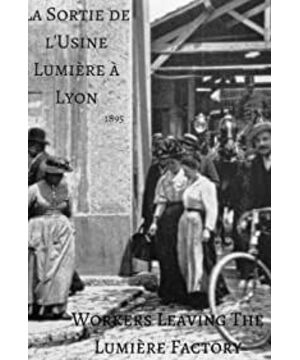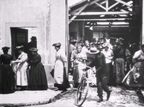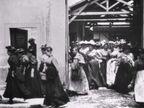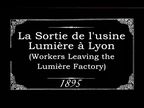An excerpt from this article translated from the first chapter of the book Cinéma français by Vincent Pinel
Friday, March 22, 1895
At the National Association for the Promotion of Industry in Paris, Louis Lumiere presented a report on his photographic research, which he explained using fixed projections in black and white and color. In addition to the speech, he also introduced his latest invention: an unnamed device that can project continuous photos on the screen. The huge images of the flow of workers shocked the audience present. These workers passed through the gate of Lumière's factory in Mont Pravasier, Lyon, and then scattered and left (it is almost an advertising image!).
The Lumière and his sons (father Antoine and his two sons, Angus and Louis) were amazed by the enthusiasm shown by the audience, and they asked all three of them.
Historians are very unanimous that the film projector was born on December 28, 1895 in the "Big Café". In fact, this marks the date when Louis Lumiere's invention began to be put into commercial operation. So we should remember March 22, 1895, when the movie projector was first shown to the public. In this case, for the general public, the emergence of business rules is less important than the birth of new inventions.
Lumiere's film projector is a continuation of the high-speed continuous photography (chronophotographie) invented by Etienne-Jul Marais, and the motion picture film and the kinetoscope (Kinetoscope) invented by Thomas A. Edison. We speculate that Lumière's research (beginning with Angusta and then turning to Louis) made continuous progress in the early autumn of 1894. According to Charles Mvasson, the chief mechanic of the Mont Pravasil factory, recalled this scene: Antoine Lumière came to my office, and Louis was there at this time. He took out from his pocket a piece of film for a mobile cinema projector he had obtained from an Edison dealer. He said solemnly to Louis: "This is what you should do. Edison sold these films at incredible prices. His dealers (the Werner brothers) are trying to achieve cheaper prices. Film made in France."
Economic motivation is what triggered Lumiere to start the business. But soon, a new idea came into his mind: projecting moving images on the big screen. In order to make money, Edison insisted on confining the image to the internal projection box of the event movie projector, in order to be used only by a single audience. On the contrary, the Lumiere family's dream is to make these images visible to more people. From this perspective, March 22 is a historical milestone: for the first time, viewers can see a certain period of continuous photography on the big screen. Unless there is other evidence to the contrary, no other opinions can contend with it.
After normal operation, the equipment was perfected within a year, as evidenced by the numerous exchanges between the Lumière brothers and Carpentier, the manufacturer of the series of equipment. Obviously, the Lumiere brothers are still hesitant on the use and development of the equipment: Will he be a scientific instrument or a device for enthusiasts or professionals? This hesitation is intuitively manifested in the dystocia named for him: Antoine Lumière wanted to call him Domitor, and the Lumière brothers decided to call it the Cinématographe film projector after careful consideration...
Lumiere’s business is the direct sale of equipment and motion picture film. But in the autumn of 1895, perhaps under the pressure of Antoine Lumiere, he decided not to sell the equipment anymore, and the Lumiere brothers retained their franchise. The company will organize public and paid screening activities, train a large number of photographers and projectionists all over the world to screen and record films for it, and rely on its extensive dealer network to ensure independent operation.
View more about Leaving the Factory reviews






